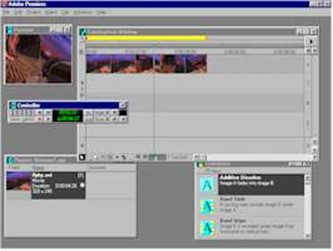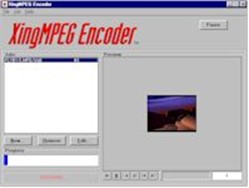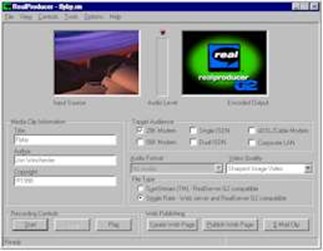4. Videos
Video Recording is the process of recording still or moving images electronically, rather than photochemical as in photographic film.
The delivery of video on web pages has tilled recently been fraught with difficulty. Lack of standards and support a few years ago were major issues. The reality of the Internet and lack of available bandwidth means that delivery of video content is severely restricted to simple slow moving content (such as people speaking face to face or teachers delivering lectures) and in very small frame windows (of 320×240 or less). The frame rate (the number of images displayed per second) has also been a problem, with a lot of real-time video (such as net meeting or video conferencing software) achieving rates of 10 frames per second (fps) or less. Around 15fps is the minimum frame rate required for smooth movement. Television frame rates are 30fps for NTSC (American standard) and 25fps for PAL (Europe, NZ standard).
The more frames per second the more realistic movement appears. However, this requires greater bandwidth. With video we are stretching the limits considerably. The features of video are
-
content keeps changing so we need a reasonable frame rate else the motion appears jerky
-
the window size needs to be a reasonable size to ensure enough detail is perceived
-
sound is added for maximum effect
edu.uptymez.com
Every increase in a video parameter means you require more bandwidth. For instance, more frames per second require more bandwidth. Larger window sizes require more bandwidth. A video with audio needs more bandwidth than a video that has no audio.
Just what are the bandwidth requirements of a video image? Well, that depends on the size of image, the color depth, the frame rate and a number of other factors. Consider a 15fps video using 256 color (8-bit color depth) of 320×240 in size, lasting 10 seconds in duration. The bandwidth per second required for this is
15 * ((320 * 240) * 8) = 9.216Mbps
This does not even include audio yet. As you can see, this video cannot be played over the Internet using a dial-up 28.8Kbps connection. In fact, it would not even play on some personal computers. What is needed is a mechanism of reducing the information in the video to a much smaller size (i.e., reduce the bandwidth required). This is achieved by eliminating redundant information from the video, and compressing what’s left. This is called compression. The device (either in software or hardware) that does compression of the video and decompresses it ready for playing is called a codec.
Frame Sizes and Formats
There is a number of common video formats for personal computers. The three most common formats available today are
-
MOV (Developed and supported by Apple Inc.)
-
AVI (Developed and supported by Microsoft.)
-
MPEG
edu.uptymez.com
Video has standardized on a 4:3 ratio. This ratio is an accepted standard. Typical video sizes are
-
320 x 240
-
160 x 120
edu.uptymez.com
When producing video for multi-media productions such as CD-ROM and the Internet, you should adhere to common standards. This means using commonly accepted frame sizes, frame rates, color depths, compression codecs and video formats. Using a non-standard format may cause problems in playback on the client computer, such as the inability to play the video.
Codec
Codec isthe hardware that can convert audio or video signals between analog and digital forms.
Codec compresses and decompresses the video stream. When a codec is applied, it looks at the original video stream and changes it, saving the result to a file. When the file is played back, the codec interprets the changes and attempts to reconstruct the original video stream.
A lossless compression scheme preserves the original data, so that the resultant video after decompression looks the same as that before it was compressed. Most lossless compression schemes use run length encoding (RLE). This works well with computer generated images, but is not very effective when applied to digitized video. The reason for this is because RLE works by discarding continuous regions that have the same colors. Computer generated images tend to have more solid colors than digitized video, so RLE is more effective for these.
A lossy compression scheme removes data from the video stream that the viewer is unlikely to notice. The amount of information that is lost depends on how much compression is applied.
A spatial compression scheme compresses the information in every frame. This can result in blurring, blockiness (small blocks of the same color) and streaking (lines of the same color).
A temporal compression scheme compresses the data by comparing frames over time. Frame differencing is a type of temporal compression that stores data for only the frames that contain changes. This can result in blockiness.
The following is a summary of the more common video codecs supported by personal computers (as at Dec 1998).
|
Video Codec |
Description |
|
Run length encoding is a technique that discards continuous regions that have the same color. It is suitable for 8-bit (256) color video. |
|
|
Indeo |
Use this codec to compress 24-bit color for playback from CD-ROM, or for the original digital video capture. |
|
Cinepak |
Use this codec to compress 24-bit video for playback from CD-ROM. The codec is much faster at decompressing that compressing so is good for playback of moving video content. |
|
Microsoft Video 1 |
This codec is a lossy, spatial compressor. It supports 8-bit and 16-bit color. |
edu.uptymez.com
Key frames
A key frame contains the entire image information and is used as a reference for subsequent frames in a sequence. In the illustration below, key frames are repeated every seven frames. Intermediate frames that occur between key frames only contain the changes between that frame and the key frame. This method reduces the file size of the video.

The intermediate frames are called delta frames.
AVI (Audio Video Interleave)
AVI is a format Microsoft introduced with the Windows 3.1 operating system. It intermixes both audio and video content within the file. The video and audio streams in the file are stored sequentially, without time stamps. A header in the file indicates the rate at which the video and audio streams are to be played. The audio stream is stored as a WAV file.
MPEG (Moving Picture Experts Group)
The MPEG-1 standard was adopted in 1991. The goal of MPEG-1 was to develop a way of compressing a video signal and then play it back using a CD-ROM or telephone line. A digital bit rate of less than 1.5 Mbps was considered necessary. The standard specifies 352×240 pixels at 30 frames per second. The quality is acceptable for the home consumer market.
The MPEG-2 standard was designed to deliver better quality images and larger video size, suitable for broadcast quality. MPEG-2 specifies a data rate of 6.0Mbps.
The MPEG-4 standard is currently under development (as at Dec 98).
-
Compression of both audio and video
-
encodes changes in image motion that occurs from frame to frame
-
audio is split into 32 sub-bands
-
video compression levels of 50:1 to 200:1
-
audio compression levels of 5:1 to 10:1
-
MPEG-1 data rate up to 1.5Mbps
-
MPEG-2 data rate up to 10Mbps
edu.uptymez.com
Streaming Video
Streaming video is very similar to streaming audio. We are faced with the same problem of file size and the delay involved in downloading the entire video file before it can be played on the client computer. Streaming video addresses the issue of this delay by allowing the file to be played whilst it is still being downloaded. A special player is required for viewing and playing streaming video.
Streaming video is primarily associated with Real Networks. “Real Player” and “Real Player G2” support the playing of streaming video (and audio) over the Internet. The advantages of using streaming video are
-
the use of a special codec that reduces the bandwidth requirements for video
-
instant playing of the video clip
-
suits limited bandwidth connections (i.e., a dial-up user with a 28.8Kbps modem)
edu.uptymez.com
When a user selects a streaming video clip, the streaming video player contacts the server and establishes the bandwidth and delays between the user computer and the host server. A few seconds of the clip is then downloaded into temporary buffer storage before the clip begins to play. As the clip begins to play, more content is downloaded and placed into temporary storage. If there is a congestion delay in the Internet connection, the clip continues to play using the contents of the buffer storage. Hopefully, before the buffer storage is exhausted, the congestion delay will cease and thus the buffer storage will fill up again. In this manner, the streaming player tries to achieve smooth playback of the clip. Without using storage, gaps or breaks in the video would be evident when a congestion delay occurred.
A special content provider program is necessary for producing streaming video clips. A limited free version can be downloaded from the Real Networks web site. In addition, to provide streaming video clips from a server requires the use of a streaming server.
Video Production tools
The following is a very brief description of three common video production tools for the creation and conversion of video content suitable for CD-ROM or Internet production.
Adobe Premiere
This video editing and production software is excellent for designing and producing video content.
|
Any number of video streams and audio channels can be combined with transition effects (how one video stream is changed to a different video stream) into a single video. It supports a wide variety of frame formats, frame sizes and codecs. It is ideal for producing video content for CD-ROM. |
|
edu.uptymez.com
XING MPEG Encoder
This package converts an AVI file to MPEG format.
|
|
Often, AVI files can be further reduced in file size by conversion to MPEG format. The XING encoder is relatively inexpensive and should be considered as an option for any serious multi-media developer. This package cannot be used to create AVI or MPEG content. It can only convert existing AVI files to MPEG format. |
edu.uptymez.com
Real Producer G2
This package converts an existing AVI file to streaming video format.
|
It is a free download from Real Networks. A player is required to play the generated video stream. In addition, a streaming server is recommended to handle the delivery of streaming video content over the Internet. It is possible to place limits on the data rate of the video content when it is created. This product can also produce live streaming video content and slide shows (graphics plus optional audio). |
|
edu.uptymez.com
Other Considerations
The following is a video file (© J. Winchester) of just over 4 seconds duration. It comprises a 320×240 animation. The common settings for each AVI file has been set to 15fps, 80% compression level with key frames every 15 frames. The data rate has been limited to 100KB/s. The audio has been set to 11KHz 8-bit mono.
|
Video Type |
File Size |
|
|
|
 |
493KB |
Cinepak codec |
CD-ROM only |
|
 |
491KB |
Microsoft Video 1 |
CD-ROM only |
|
 |
1287KB |
Intel Indeo(R) Video 3.2 |
CD-ROM only |
|
 |
747KB |
Converted with XingMPEG encoder |
CD-ROM only |
|
 |
25KB |
Data rate set to 28.8Kbps, smoothest motion |
|
|
 |
13KB |
Data rate set to 28.8Kbps, sharpest image |
|
|
 |
31KB |
Data rate set to 56Kbps, smoothest motion |
CD-ROM only |
|
 |
24KB |
Data rate set to 56Kbps, sharpest image |
CD-ROM only |
edu.uptymez.com
View each of the video files as shown above. Compare them for quality of image and smoothness of motion. One observation you will find is that for streaming video, smoothest motion is best for content that is moving, but the image quality is lower. This illustrates that tradeoffs are made in compression between motion and quality. Compare also the data rate of 28.8K versus 56K. Is there a discernable difference between the two clips?
The type of options and codec you choose directly relate to the content of the video you are generating.


